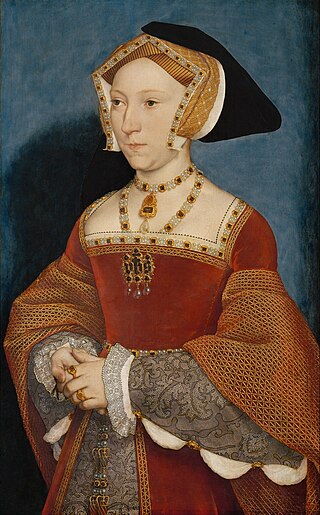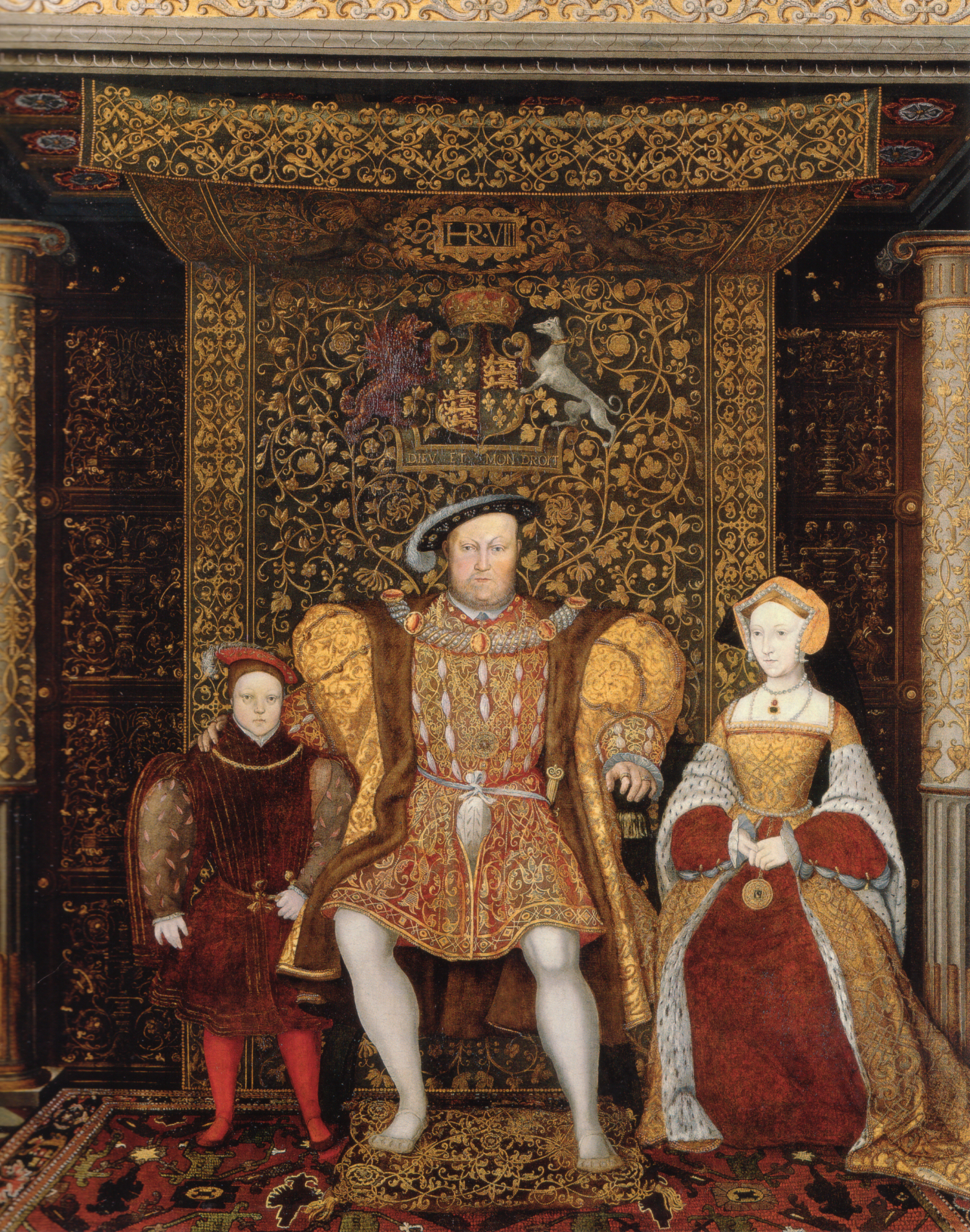by Susan Flantzer © Unofficial Royalty 2013

Jane Seymour, Queen of England; Credit – Wikipedia
Jane Seymour was the daughter of Sir John Seymour and Margery Wentworth. Jane’s birth date is unknown, but she was probably born around 1508, most likely at the family home, Wolf Hall in Wiltshire. The Seymours were descendants of a supporter of William the Conqueror, who took his name from St. Maur-sur-Loire in Touraine, France, and were also descendants of King Edward III of England through his son Lionel of Antwerp, 1st Duke of Clarence. Jane, Henry VIII’s second wife Anne Boleyn, and Henry VIII’s fifth wife Catherine Howard all shared a great-grandmother and were second cousins. Anne and Catherine were also first cousins.
Jane Seymour had eight siblings. Two of her brothers, Edward and Thomas, were executed during the reign of her son King Edward VI.
- Edward Seymour, 1st Duke of Somerset, Lord Protector of King Edward VI (c. 1500 – 1552), married (1) Catherine Fillol, had issue; (2) Anne Stanhope, had issue
- Sir Henry Seymour (1503 – 1578) married Barbara Wolfe, had issue
- John Seymour (1504 – 1510)
- Thomas Seymour, 1st Baron Seymour of Sudeley (c. 1508 – 1549) married Catherine Parr, sixth wife and widow of King Henry VIII, had one daughter Mary; Catherine died due to childbirth complications, and there is no mention of Mary after her second birthday
- Anthony Seymour (died c. 1528)
- Elizabeth Seymour (c. 1518 – 1568), married (1) Sir Anthony Ughtred, had issue; (2) Gregory Cromwell, 1st Baron Cromwell of Oakham, son of Thomas Cromwell, chief minister of King Henry VIII, had issue (3) John Paulet, 2nd Marquess of Winchester, no issue
- Margery Seymour (died c. 1528)
- Dorothy Seymour, married (1) Sir Clement Smith, had issue; (2) Thomas Leventhorpe of Shingle Hall, no issue
Jane’s education was not academic, but rather practical. She learned household management and needlework. Her embroidery was said to have been beautiful and elaborate. Jane became a maid of honor to Catherine of Aragon, Henry VIII’s first wife, and then to Anne Boleyn, Henry VIII’s second wife. In September 1535, Henry stayed at Wolf Hall, the Seymour family home, and it may have been then that he first noticed Jane. However, the first evidence of Henry’s interest in Jane was not until February of 1536 when Henry’s disinterest in Anne was obvious and Jane was thought likely to become Henry’s third wife. Jane is said to have resisted Henry’s attempts to make her his mistress.
On May 30, 1536, King Henry VIII was married to Jane Seymour, his third wife, by Thomas Cranmer, Archbishop of Canterbury in a private ceremony held in the Queen’s Closet at Whitehall Palace. Henry and Jane had been betrothed on May 20, 1536, a day after the execution of Henry’s second wife Anne Boleyn.
Although Henry wanted Jane to have a coronation, she was never crowned. At first, the coronation was postponed because of the plague in London, and then it was postponed further because of her pregnancy. Jane had known Mary, Henry’s daughter since the days she served as maid of honor to Mary’s mother, Catherine of Aragon, and she was able to reconcile father and daughter. Through Jane’s influence, Mary was brought back to court.
Early in 1537, Jane became pregnant. The joyous king fulfilled Jane’s every desire and emsured the best doctors and midwives attended her. As was tradition, Jane went into confinement a month before the baby’s due date. At 2 AM, on October 12, 1537, the long-awaited male heir was born at Hampton Court Palace. Jane’s labor had been long, two days and three nights. Three days later, the baby was christened Edward after Edward the Confessor whose feast day is October 13. His half-sisters Mary (daughter of Catherine of Aragon) and Elizabeth (daughter of Anne Boleyn) attended the ceremony along with his mother who was carried on a litter.

Prince Edward (future Edward VI), Henry VIII, Jane Seymour painted in 1545, eight years after Jane’s death; Credit: Wikipedia
On October 17, 1537, Jane’s condition deteriorated and she was given the last rites. She died at Hampton Court Palace on October 24, 1537, most likely from puerperal fever or childbed fever, a bacterial infection. The majority of child-bed fever cases were caused by the birth attendants. With no knowledge of germs, it was believed that hand washing was unnecessary.
Jane was buried on November 12, 1537, in St. George’s Chapel at Windsor Castle. Mary, Henry VIII’s elder daughter, was the chief mourner. Henry’s plans to build a magnificent monument over Jane’s tomb never happened. In 1547 and three wives later, Henry VIII died and was laid to rest with Jane. In 1649, after his execution by beheading, King Charles I was laid to rest in the same vault as Henry and Jane. The only memorial to the three is a plaque on the floor put there by King William IV in 1837. Jane and Henry’s son Edward succeeded his father, but his reign was short. King Edward VI died at the age of 15 and was succeeded by Henry’s daughter with Catherine of Aragon (Queen Mary I) who was then succeeded by Henry’s daughter with Anne Boleyn (Queen Elizabeth I).

Coffins of King Henry VIII (center, damaged), Queen Jane (right), King Charles I with a child of Queen Anne (left), vault under the choir, St George’s Chapel, Windsor Castle, marked by a stone slab in the floor; Credit – Wikipedia

Slab in the floor indicating tomb of Henry VIII, Jane Seymour, Charles I, and an infant child of Queen Anne; Credit – onthetudortrail.com
This article is the intellectual property of Unofficial Royalty and is NOT TO BE COPIED, EDITED, OR POSTED IN ANY FORM ON ANOTHER WEBSITE under any circumstances. It is permissible to use a link that directs to Unofficial Royalty.
England: House of Tudor Resources at Unofficial Royalty
